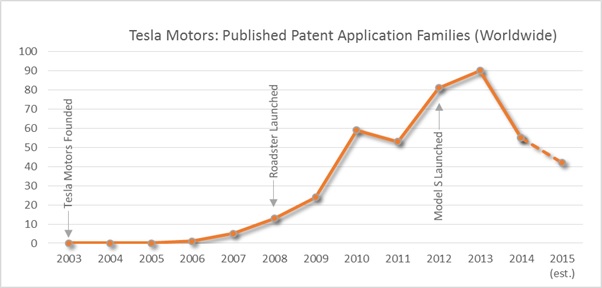15/06/2015
In August of last year, we posted an article reporting a decision by Tesla Motors to open its patent portfolio to others wishing to make use of its technology “in good faith”. As Elon Musk, the founder and CEO of Tesla Motors, blogged in June of that year, this decision was made “in the spirit of the open source movement, for the advancement of electric vehicle technology”.
This article attempts to dig into Tesla’s patent filing statistics to see if the decision is reflected in the company’s patent filing activity.
As shown in the graph below, the number of Tesla’s patent application families published each year (where each “family” is a set of patent applications filed in different countries for the same invention) increased rapidly from zero in 2003, when Tesla was founded, to a peak of 90 in 2013, the year after the highly successful Model S was launched. This rise in patenting activity is fairly indicative of an innovative company bringing a new product to market and with a keen desire to use patent protection to protect its technology. However, following the 2013 peak, the number of published families dropped markedly to 55 in 2014. Furthermore, based on the number of patent application families published so far in 2015, the total number is set to be even less this year; at somewhere in the region of 42 published patent application families. This would represent a 53% drop from the number of patent applications published in 2013 and would indicate a marked change in Tesla’s patent filing activity 1.

Before continuing further, here comes the caveat: although publication data offers a reliable measure of patenting activity, this measure lags behind the actual situation by a considerable margin, since patent applications are generally not published until 18 months after filing. So, in effect, publication data for any given year typically represents the patent filing activity from 18 months beforehand, rather than the current activity. Obviously, this makes it difficult to accurately determine whether Tesla’s patent filing strategy has decreased since the June 2014 announcement that it would open up its patent portfolio to others, or indeed whether it has picked up again following the recent drop.
Interestingly, one thing we can say from the 18 month delay is that that the majority of applications published in 2014 are likely to have been filed during 2013 and the tail end of 2012, i.e. before Tesla’s announcement that it would open its patent portfolio to others. So, based on this, it would appear that the announcement that Tesla would open its patent portfolio was preceded by a significant reduction in patent filing activity.
The reduction in filing activity could be due to a number of factors. For example, it may simply be due to the fact that the technology developed by Tesla is maturing, leading to a slowing down in the rate of innovation and, consequently, the number patent of applications filed. Alternatively, and perhaps more significantly, it may be due to a conscious shift in the company’s patenting strategy. Aside from the inference that can be taken from Elon Musk’s critical assessment of the patenting system in his June 2014 address, the wording of Tesla’s 2014 Annual Report also hints at a possible shift in Tesla’s approach to patenting. In particular, Tesla’s previously standard statement stressing the importance of intellectual property to the future success of the company and its intention to continue to seek patent protection for its technology, which featured in all previous
Annual Reports released since Tesla’s Nasdaq debut in 2010, was conspicuously absent from the 2014 Annual Report, released in February 2015 2.
So has Tesla given up on patent protection entirely? No; for now it seems not. Despite the large decrease in Tesla’s publications since 2013, the evidence is that Tesla is still prosecuting pending applications to grant and are still filing new patent applications, albeit seemingly in reduced numbers. Of the 19 patent application families published in 2015, 8 were filed after Tesla’s announcement of June 2014. So, patent protection is still being sought by Tesla. This is important, not only for Tesla, but also for others who wish to further develop similar technologies.
By continuing to seek patent protection for its innovations, Tesla can use the resulting patents to restrict the activities of others who may wish to use its technologies in “bad faith” (or whatever Tesla takes that to mean). It also affords Tesla the option of reversing its “open patent” decision at some stage in the future. Elon Musk has stated that the company’s main competitors are not those companies already producing electric vehicles “but rather the enormous flood of gasoline cars pouring out of the world’s factories every day” and that applying an open source philosophy should encourage other companies to join the fray. However, this may not be the case indefinitely. As electric vehicles replace conventional vehicles, competition from other electric vehicle manufacturers making free use of Tesla’s patented technology could erode Tesla’s profits to such an extent that the open philosophy is no longer viable. The 20 year life of a patent is a long time in such a young, fast-moving market and by continuing to apply for patent protection, Tesla can keep its options open.
Additionally, and crucially, the foundation on which the entire patent system is built is the idea that a monopoly right is granted in exchange for a full public disclosure of how an invention may be reduced to practice. A key purpose of the patent system is thus to codify innovation and provide a springboard for further developments. Were Tesla to stop patenting its innovations entirely, the lack of any public disclosure of its technologies could hinder development, not only in the electric vehicle sector, but also in related sectors, unless other ways are found to systematically publish the details of Tesla’s innovations. By continuing to seek patent protection, Tesla’s innovations continue to be published in detail, enabling other innovators to build upon their developments (notwithstanding the fact that the legal position surrounding Tesla’s non-enforcement of its patent rights is not entirely clear at present). These further developments may help to drive demand in related sectors, such as wind and solar energy storage, leading to economies of scale and consequently to an increase in capital available for further investment in R&D activities.
So, although the patent filing statistics suggest that Tesla’s patent filing activity has dropped markedly since 2013, the figures also suggest that the company has not given up entirely on the patenting system, for the time being at least. This is good news both for Tesla and for other innovators working with similar technologies. Whether or not this will remain the case is difficult to say. Niels Bohr once quipped that “predictions can be very difficult – especially about the future”. They are even more difficult when the “present” is already 18 months in the past.
- Source: LexisNexis, TotalPatent®. The estimate for 2015 is based on the number of applications published from 1 Jan 2015 to 1 June 2015 (19 patent application families) multiplied by 1/0.451, where 0.451 is the average number of families published in the same period in each of the previous five years expressed as a ratio of the total number of families published in that year.
- Tesla Motor’s 2010-2013 Annual Reports all contain the statements that the company’s “success depends, at least in part, on our ability to protect our core technology and intellectual property” and that “We intend to continue to file additional patent applications with respect to our technology”. Neither statement was included in the 2014 Annual Report, which was published in February 2015.
This article is for general information only. Its content is not a statement of the law on any subject and does not constitute advice. Please contact Reddie & Grose LLP for advice before taking before any action in reliance on it.

